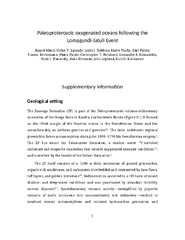Blar i forfatter "Mänd, Kaarel"
-
Authigenesis of biomorphic apatite particles from Benguela upwelling zone sediments off Namibia: The role of organic matter in sedimentary apatite nucleation and growth
Mänd, Kaarel; Kirsimäe, Kalle; Lepland, Aivo; Crosby, Chris H.; Bailey, Jake V.; Konhauser, Kurt O.; Wirth, Richard; Schreiber, Anja; Lumiste, Kaarel (Journal article; Tidsskriftartikkel; Peer reviewed, 2018-07-30)Sedimentary phosphorites comprise a major phosphorus (P) ore, yet their formation remains poorly understood. Extant polyphosphate‐metabolizing bacterial communities are known to act as bacterial phosphate‐pumps, leading to episodically high dissolved phosphate concentrations in pore waters of organic‐rich sediment. These conditions can promote the precipitation of amorphous precursor phases that are ... -
Chromium evidence for protracted oxygenation during the Paleoproterozoic
Mänd, Kaarel; Planavsky, Noah J.; Porter, Susannah M.; Robbins, Leslie J.; Wang, Changle; Kreitsmann, Timmu; Paiste, Kärt; Paiste, Päärn; Romashkin, Alexander E.; Deines, Yulia E.; Kirsimäe, Kalle; Lepland, Aivo; Konhauser, Kurt O. (Journal article; Tidsskriftartikkel; Peer reviewed, 2022-03-24)It has commonly been proposed that the development of complex life is tied to increases in atmospheric oxygenation. However, there is a conspicuous gap in time between the oxygenation of the atmosphere 2.4 billion years ago (Ga) and the first widely-accepted fossil evidence for complex eukaryotic cells . At present the gap could either represent poor sampling, poor preservation, and/or difficulties ... -
Constraining the conditions of phosphogenesis: Stable isotope and trace element systematics of Recent Namibian phosphatic sediments
Lumiste, Kaarel; Mänd, Kaarel; Bailey, Jake; Stüeken, Eva E.; Paiste, Kärt; Lang, Liisa; Sepp, Holar; Lepland, Aivo; Kirsimäe, Kalle (Journal article; Tidsskriftartikkel; Peer reviewed, 2021-03-31)Modern phosphogenesis occurs on continental margins influenced by upwelling and high primary productivity. The formation of phosphatic sediments is coupled to global climate fluctuations, biological cycling of phosphorus and local redox conditions. Although the processes involved in phosphogenesis are well described, high-resolution data on the redox and stable isotope systematics in Recent in-situ ... -
Identifying global vs. basinal controls on Paleoproterozoic organic carbon and sulfur isotope records
Paiste, Kärt; Lepland, Aivo; Zerkle, Aubrey L.; Kirsimae, Kalle; Kreitsmann, Timmu; Mänd, Kaarel; Romashkin, Alexander E.; Rychanchik, Dimitry V.; Prave, Anthony R (Journal article; Tidsskriftartikkel; Peer reviewed, 2020-06-03)Paleoproterozoic sedimentary successions are important archives of the redox evolution of Earth’s atmosphere and oceans. Efforts to unravel the dynamics of our planet’s early oxygenation from this archive rely on various geochemical proxies, including stable carbon and sulfur isotopes. However, ancient metasedimentary rocks often experienced early- and late-stage (bio)geochemical processes making ... -
Iron Isotopes Reveal a Benthic Iron Shuttle in the Palaeoproterozoic Zaonega Formation: Basinal Restriction, Euxinia, and the Effect on Global Palaeoredox Proxies
Mänd, Kaarel; Lalonde, Stefan V.; Paiste, Kärt; Thoby, Marie; Lumiste, Kaarel; Robbins, Leslie J.; Kreitsmann, Timmu; Romashkin, Alexander E.; Kirsimäe, Kalle; Lepland, Aivo; Konhauser, Kurt O. (Journal article; Tidsskriftartikkel; Peer reviewed, 2021-03-31)The Zaonega Formation in northwest Russia (~2.0 billion years old) is amongst the most complete successions that record the middle of the Palaeoproterozoic era. As such, geochemical data from the formation have played a central role in framing the debate over redox dynamics in the aftermath of the Great Oxidation Event (GOE). However, uncertainty over local redox conditions and the degree of ... -
The kaolinite shuttle links the Great Oxidation and Lomagundi events
Hao, Weiduo; Mänd, Kaarel; Li, Yuhao; Alessi, Daniel S.; Somelar, Peeter; Moussavou, Mathieu; Romashkin, Alexander E.; Lepland, Aivo; Kirsimäe, Kalle; Planavsky, Noah J.; Konhauser, Kurt O. (Journal article; Tidsskriftartikkel; Peer reviewed, 2021-05-19)The ~2.22–2.06 Ga Lomagundi Event was the longest positive carbon isotope excursion in Earth’s history and is commonly interpreted to reflect perturbations in continental weathering and the phosphorous cycle. Previous models have focused on mechanisms of increasing phosphorous solubilization during weathering without focusing on transport to the oceans and its dispersion in seawater. Building from ... -
Multiple sulphur isotope records tracking basinal and global processes in the 1.98 Ga Zaonega Formation, NW Russia
Paiste, Kärt; Lepland, Aivo; Zerkle, A.L.; Kirsimäe, Kalle; Izon, G.; Patel, N.K.; McLean, F.; Kreitsmann, T.; Mänd, Kaarel; Bui, T.H.; Romashkin, Alexander E.; Rychanchik, Dimitry V.; Prave, Anthony R (Journal article; Tidsskriftartikkel; Peer reviewed, 2018-09-19)The exceptionally organic-rich rocks of the 1.98 Ga Zaonega Formation deposited in the Onega Basin, NW Russia, have refined our understanding of Earth System evolution during the Paleoproterozoic rise in atmospheric oxygen. These rocks were formed in vent- or seep influenced settings contemporaneous with voluminous mafic volcanism and contain strongly <sup>13</sup>C-depleted organic matter. ... -
Palaeoproterozoic oxygenated oceans following the Lomagundi–Jatuli Event
Mänd, Kaarel; Lalonde, Stefan V.; Robbins, Leslie J.; Thoby, Marie; Paiste, Kärt; Kreitsmann, Timmu; Paiste, Päärn; Reinhard, Christopher T.; Romashkin, Alexandr E.; Planavsky, Noah J.; Kirsimäe, Kalle; Lepland, Aivo; Konhauser, Kurt O. (Journal article; Tidsskriftartikkel; Peer reviewed, 2020-03-16)The approximately 2,220–2,060 million years old Lomagundi–Jatuli Event was the longest positive carbon isotope excursion in Earth history and is traditionally interpreted to reflect an increased organic carbon burial and a transient rise in atmospheric O<sub>2</sub>. However, it is widely held that O<sub>2</sub> levels collapsed for more than a billion years after this. Here we show that black shales ... -
REE+Y uptake and diagenesis in Recent sedimentary apatites
Lumiste, Kaarel; Mänd, Kaarel; Bailey, Juke; Paiste, Päärn; Lang, Liisa; Lepland, Aivo; Kirsimäe, Kalle (Journal article; Tidsskriftartikkel; Peer reviewed, 2019-07-30)Rare Earth Elements and Yttrium (REE+Y) distribution in authigenic phases are frequently used as proxies for reconstructing past seawater conditions. Sedimentary apatite precipitates near the sediment-water interface and is therefore capable of recording the REE+Y composition of the overlying water column. While the overprinting of primary REE+Y signal during late stage diagenesis is a widely known ...


 English
English norsk
norsk







